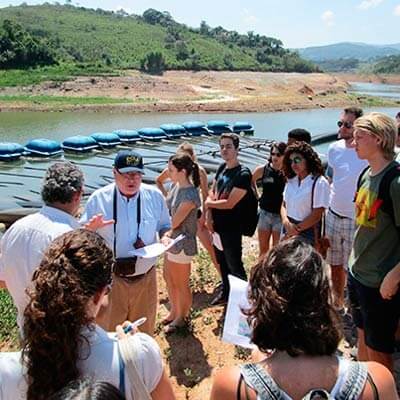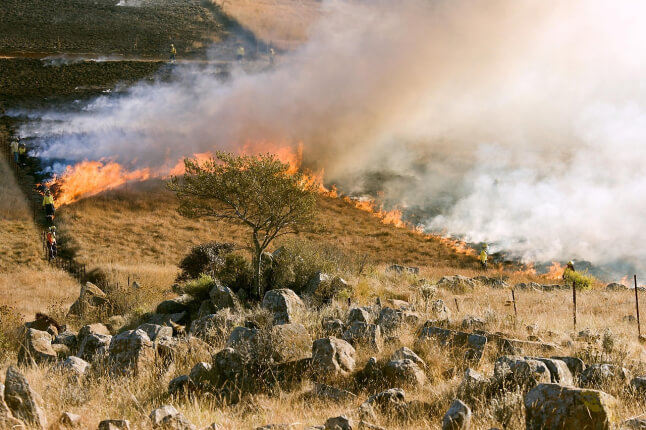News
Sustainability issues in urban cities brought together Harvard and Brazilian students during a 10-day workshop in São Paulo. Professor Rubem Porto explained the current state of the severe drought in the Sistema Cantareira reservoir system near the temporary floating pumps used to extract water from the dead space of the reservoir. (Photo by Patrick Ulrich.)
Floating water pumps for too-low reservoirs, gigantic molds for windmill blades, bustling control centers for subway trains — and for the traffic snarling the roads above — were among the sustainable sights viewed by Harvard and Brazilian students in São Paulo over winter break.
The group, made up of 15 students from Harvard and 15 from the University of São Paulo, was participating in the sixth annual collaborative field course between the institutions. The 10-day program was heavy on hands-on, keeping students busy with field work, which in addition to the pumps, blades, and control center included visits to the headquarters for Santander Bank and the Tower Bridge building, both of which incorporate green design principles, as well as a facility where waste water is recycled for industrial purposes.
“The students get so much more by actually experiencing it,” said Patrick Ulrich, assistant director for undergraduate studies in environmental science and engineering at the School of Engineering and Applied Sciences (SEAS) and one of the course’s organizers. “I thought it was really fantastic this year; the students we had were really great.”
University of São Paulo Professor José Carlos Mierzwa answered questions at the Aquapolo Ambiental water reuse plant. The purple pipe, the standard color for identifying treated reuse water, delivers water to local industrial customers. (Photo by Patrick Ulrich.)
The course included talks by experts at each site, but it wasn’t all work and no play. An important part of the mission, said Associate Professor of Environmental Engineering Chad Vecitis, is the interaction between Harvard students and faculty and their Brazilian counterparts.
This year’s program was centered on sustainable cities. Beyond exposing students to sustainability issues in an urban environment, the goal was to allow them to compare how solutions are sought in different cultures.
“The idea is to get them thinking about the emerging megacity, one that is growing too fast for its infrastructure,” Vecitis said, citing in addition to São Paulo’s crowded streets its reservoirs, so drained by a two-year drought that the water is 20 meters below the intakes, necessitating floating pumps to keep water flowing.
Harvard students involved in the trip — which was sponsored by SEAS, the David Rockefeller Center for Latin American Studies, and the University of São Paulo — gave it high marks for both the work and the cultural exchange that the format fostered.
Students were broken into five groups of six, split between Harvard and Brazilian students. They collaborated on a final project, and along the way — during down time, dinners, and nights on the town — got to know each other and each other’s cultures.
“They got to see what other students think is interesting, rather than what faculty members think is interesting,” Ulrich said.
For Johnathan Budd, a senior electrical engineering concentrator, the highlight was the visit to a factory where windmills are made. He and his fellow students got to see the blades being fashioned, the raw fiberglass fibers and bonding material being poured into the mold before being baked into the final product.
“That was really cool to me,” Budd said.
Read the entire article in the Harvard Gazette
In their own words
Thirty students took part in the 10-day collaborative course with the Escola Politécnica da Universidade de São Paulo (Poli-USP) and Harvard School of Engineering and Applied Sciences (SEAS).
Jahred Liddie '16 wrote an account of the trip for the Office for Sustainability website.
The students also kept a blog while they were abroad. Read "Impressions from the Field" for their full account of the experience.
Photo by Jill Larson.
Topics: Environment
Cutting-edge science delivered direct to your inbox.
Join the Harvard SEAS mailing list.



